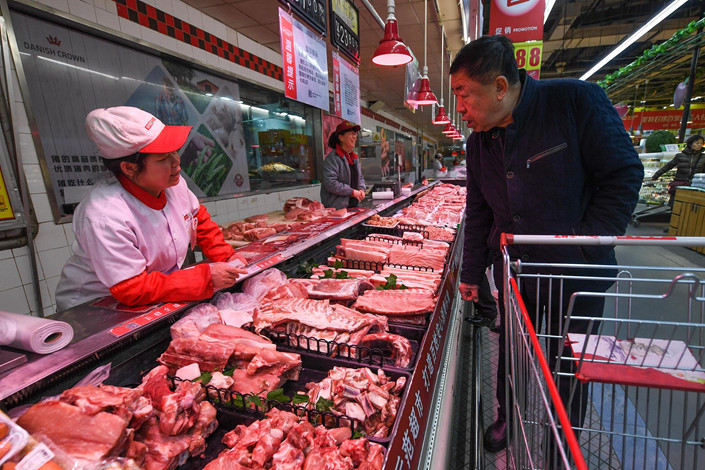Sluggish Demand Can’t Break Swine Fever’s Grip on Pork Prices

Pork prices increased in March despite sluggish demand, underlining that the meat has been in short supply as African swine fever has continued to spread around the country, analysts said.
The average price for a live Waisanyuan pig — a predominant breed in China — was at 15.22 yuan ($2.27) per kilogram nationwide on Monday, a 24% jump from the end of February, according to industry tracker Zhujiage.com.
The price of pork has also been on the rise in March. The average price for lean pork meat was 20.16 yuan per kilogram from March 11 to March 15, an increase of 13.9% from the previous week, according to data from the Ministry of Agriculture and Rural Affairs.
Pork prices are up despite sluggish demand for the meat in China, indicating the market is very short of supply, said Chen Qi, an analyst of Zhongtai Securities, in a research report on Sunday. He predicted that the price of pork will continue to rise in April and May.
The outbreak of African swine fever has also contributed to the supply shortage. As of mid-March, nearly 1 million pigs have died or been slaughtered due to the disease, according to official data. As a result, the number of live pigs in China was down 16.6% year-on-year last month, with the number of live breeding sows down 19.1% year-on-year, according to figures from the agriculture ministry.
Analysts have also predicted that consumer inflation will pick up as pork prices climb. The destocking of sows and a lack of willingness to raise more pigs may represent a turning point in the “hog cycle” — a reference to the cyclical fluctuations of supply and prices in the pork market, analysts have said. China witnessed four hog cycles from 2000 to 2014, and the fifth hog cycle started in 2015 with the pork price peaking in 2016. The price later dropped and remained low in 2017 and 2018.
In a bid to stabilize pig production, the agriculture ministry on Wednesday released a document (link in Chinese), suggesting local agriculture and fiscal authorities should roll out measures to provide subsidies to aid pig farms to resume production.
“This reflects the government’s concern about the pig supply, and the current policies are focused on how to guarantee the pig supply for the rest of the year,” said TF Securities analysts in a research report on Sunday.
Contact reporter Timmy Shen (hongmingshen@caixin.com)

- 1PDD Fires Government Relations Staff After Fistfight With Regulators
- 2China Ramps Up Effort to Offload Vast Supply of Unsold Homes
- 3China’s Elite-Focused Schools Are Failing Most Students, Top Educators Say
- 4In Depth: China’s Developers Try to Modernize After Surge in Subpar Homes
- 5Cover Story: Trading by Algorithm: Who is Responsible When AI Calls the Shots?
- 1Power To The People: Pintec Serves A Booming Consumer Class
- 2Largest hotel group in Europe accepts UnionPay
- 3UnionPay mobile QuickPass debuts in Hong Kong
- 4UnionPay International launches premium catering privilege U Dining Collection
- 5UnionPay International’s U Plan has covered over 1600 stores overseas






